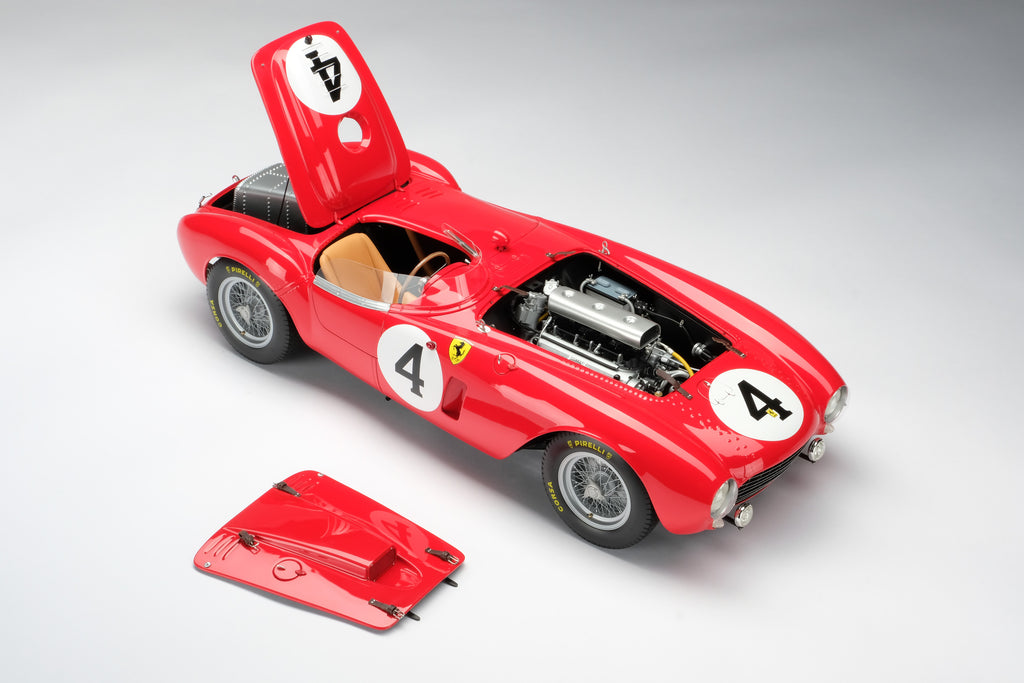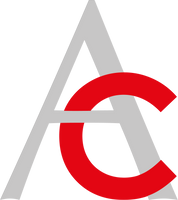
A significant car in Ferrari history
One of the most important cars in Ferrari’s illustrious history, the Ferrari 375 Plus was built to extend the success of the 375 MM that powered Ferrari to success in the inaugural FIA World Sportscar Championship in 1953. Facing the threat of being unable to match the sophisticated new 8-cylinder Formula 1 designs from Mercedes-Benz and Lancia, nor even the 6-cylinder 250Fs from Maserati, Enzo Ferrari instead focused his attention upon perfecting a line of large capacity sportscars. The result would become known by the French racing community as 'Le Monstre' and by the British as 'The Fearsome Four-Nine'. The 375 Plus competed and was victorious at the most prestigious international races, earning Ferrari its first works victory at Le Mans and cementing itself into sportscar legend in the process.
Our 1:8 scale models of the 375 Plus replicate the cars that were victorious at the iconic 24 Hours of Le Mans and in the torturous Carrera Panamericana during the 1954 World Sportscar Championship. Developed using CAD data developed from scanning an original car, chassis 0398 AM, we built the models using archive imagery and paint codes supplied by Ferrari Classiche. Scroll down to learn more about these models' stories.
Discover more about our Ferrari 375 Plus models here >
1954 Le Mans

Circuit de la Sarthe, 12-13 June 1954
Discover the full story here >
The 1954 Le Mans was a heavily rain-affected thriller, viewed by many as a battle between brute force and science: the 375 Plus up against the new 3.4-litre Jaguar D-Type with its sleek, aerodynamic bodywork. Jaguar brought D-Types straight from the factory, so fresh that they had yet to be painted when they arrived. The British team kept the majority of their 1953 driver line up, whilst Ferrari fielded a team of top drivers that included Umberto Maglioli, José Froilán González and Maurice Trintignant.
In practice, the Ferrari and Jaguars were a class above the rest of the field. The Jaguars were showing an advantage in handling, brakes and top speed, but Ferrari had the superior power and acceleration. Rain negated Ferrari's early power advantage after a fast start though, after only an hour of racing, the rest of the pack was already an entire lap behind. Moss took the lead on lap 22 before the Jaguars suffered engine misfires, allowing the Ferraris to build their lead once again.

The rain eased off as the night arrived, which permitted the Jaguars to haul themselves back into contention, as the lead Ferraris suffered their first casualty: the Maglioli/Marzotto car retiring with a broken transmission just after 11pm. Jaguar weren't without their own issues however: Moss and Walker’s D-Type suffered total brake failure at 160mph at the end of the Mulsanne straight (it took two miles of escape road for the car to roll to a stop!), whilst Wharton and Whitehead suffered fuel-line issues before withdrawing with transmission problems of their own. The Rosier/Manzon Ferrari was still running in third until dawn arrived, when the car’s gearbox jammed in second gear, forcing its retirement. Rolt and Hamilton, in the remaining D-Type, moved into second position and set about chasing the leading Ferrari of González and Trintignant. With nine hours remaining, the great rivals only had one car apiece and, as the clouds built up and rain became an ever-present threat, the prospects for the aerodynamic D-Type were starting to look promising.

González and Trintignant had a lead, but could ill afford to dangle a carrot to the pursuing Jaguar. However, the Ferrari would hesitate when restarting during a routine fuel stop, handing Jaguar the exact motivation Ferrari had feared ceding. Rolt reduced the gap to just three minutes, though, in his haste, he glanced the bank coming out of Arnage lapping a slower car, and lost two of those minutes in the pits for a bout of improvised panel beating.
With ninety minutes to run, Trintignant was maintaining a two-lap lead, and brought the Ferrari in for a routine stop. González took over, but the V12 refused to restart. Ferrari lost seven minutes as the mechanics desperately worked on the engine, before discovering that the rain had saturated the ignition wiring. Rolt was frantically waved on by his pit crew while the Ferrari was stationary, and by the time González was back out on track he was only three minutes ahead. With thunder and lightning now lashing the circuit and visibility at a minimum, Rolt pitted and handed over to Hamilton for the final assault on the Ferrari lead. After some extraordinary times in the awful conditions, the lead was cut to just 90 seconds.

González was exhausted as he had not eaten or slept through the weekend, but his pit crew urged him on. As the track dried out, he was once more able to put down the Ferrari’s power and he reached the chequered flag to win the 24 Hours of Le Mans by just under three minutes, which was around half a lap (roughly less than 5km), the closest finish for the race since 1933. The Argentinian winner had cemented his special place in Ferrari history: three years earlier, he had scored Ferrari's first F1 victory and now, in his last appearance at La Sarthe, he also gave the Scuderia their first works victory at Le Mans.
Discover the full story here >
Carrera Panamericana

Mexico, 19-23 November 1954
Discover the full story here >
The 1954 Carrera Panamericana, running from from the 19th to the 23rd of November, was the fifth and final running of the legendary Mexican sportscar race, as well as the concluding race of the 1954 World Sportscar Championship. Ferrari had already sealed the Championship title, but victory in Mexico would see them earn maximum points for the season.
Ferrari's American agent Luigi Chinetti arranged indirect sponsorship on the basis of finding private customers to buy 'the works entries'. Enzo Ferrari agreed, providing Umberto Maglioli would drive one of the 375 Plus cars, chassis 0392 AM. Chinetti had arranged to sell the car to American owner/driver Erwin Goldschmidt, and so Maglioli raced in Goldschmidt’s entry. 0392 was no stranger to the racetrack, having already competed in the Mille Miglia and at Le Mans, though it was yet to see the chequered flag.

The race was a brutal affair that incorporated no fewer than eight stages and 1,910 racing miles (3,070 kilometres) in total, stretching from Tuxtla Gutiérrez, Chiapas, to Ciudad Juárez, Chihuahua. 150 cars started the race but only 85 finished all eight stages. Maglioli completed the race in 17 hours, 40 minutes, and 26 seconds, averaging 107.93mph (173.69km/h). He ended 24 minutes ahead of his closest competitors, Phil Hill and Richie Ginther in a Ferrari 375 MM, and 111 minutes ahead of the Porsche 550 Spyder of Hans Herrman that took third position. To put this into perspective, the winner of the augural race in 1950 took ten hours longer to finish than Maglioli. Such was the performance of his car, the light aircraft carrying the Press corps covering the Carrera was unable to keep up with Maglioli, who often attained speeds of 180mph and more. This phenomenal performance vividly emphasised just how well Ferrari had perfected the 375 Plus by the end of the 1954 season.


